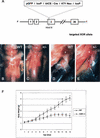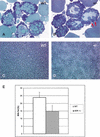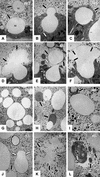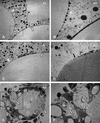The housekeeping gene xanthine oxidoreductase is necessary for milk fat droplet enveloping and secretion: gene sharing in the lactating mammary gland
- PMID: 12502743
- PMCID: PMC187506
- DOI: 10.1101/gad.1032702
The housekeeping gene xanthine oxidoreductase is necessary for milk fat droplet enveloping and secretion: gene sharing in the lactating mammary gland
Abstract
Xanthine oxidoreductase (XOR) is the rate-limiting enzyme in purine catabolism occurring in most cell types. However, this housekeeping gene is expressed at very high levels in a number of mammalian tissues including the lactating mammary epithelium, suggesting additional roles for XOR in these tissues. Mice with targeted disruption of XOR were generated to assess these potential additional roles. XOR-/- mice are runted and do not live beyond 6 wk of age. Strikingly, however, XOR+/- females, although of healthy appearance and normal fertility, are unable to maintain lactation and their pups die of starvation 2 wk postpartum. Histological and whole-mount analyses showed that in XOR+/- females the mammary epithelium collapses, resulting in premature involution of the mammary gland. Electron microscopy showed that XOR is specifically required for enveloping milk fat droplets with the apical plasma membrane prior to secretion from the lactating mammary gland. We present evidence that XOR may have primarily a structural role, as a membrane-associated protein, in milk fat droplet secretion and thus XOR provides another example of "gene sharing". About 5% of women experience primary lactation insufficiency. The above observations suggest that human females suffering from xanthinuria, a deficiency in XOR, are potential candidates for lactation problems.
Figures






Similar articles
-
Functional regulation of xanthine oxidoreductase expression and localization in the mouse mammary gland: evidence of a role in lipid secretion.J Physiol. 2002 Dec 1;545(2):567-79. doi: 10.1113/jphysiol.2002.027185. J Physiol. 2002. PMID: 12456835 Free PMC article.
-
Xanthine oxidoreductase mediates membrane docking of milk-fat droplets but is not essential for apocrine lipid secretion.J Physiol. 2016 Oct 15;594(20):5899-5921. doi: 10.1113/JP272390. Epub 2016 Aug 3. J Physiol. 2016. PMID: 27357166 Free PMC article.
-
Regulation of milk lipid formation and secretion in the mouse mammary gland.Adv Exp Med Biol. 2004;554:263-79. doi: 10.1007/978-1-4757-4242-8_22. Adv Exp Med Biol. 2004. PMID: 15384582 Review.
-
Mouse mammary gland xanthine oxidoreductase: purification, characterization, and regulation.Arch Biochem Biophys. 1999 Nov 15;371(2):308-16. doi: 10.1006/abbi.1999.1432. Arch Biochem Biophys. 1999. PMID: 10545219
-
Regulation and functional relevance of milk fat globules and their components in the mammary gland.Biosci Biotechnol Biochem. 2006 Sep;70(9):2019-27. doi: 10.1271/bbb.60142. Epub 2006 Sep 7. Biosci Biotechnol Biochem. 2006. Retraction in: Biosci Biotechnol Biochem. 2013;77(12):2013R3. PMID: 16960354 Retracted. Review.
Cited by
-
Organellar Contacts of Milk Lipid Droplets.Contact (Thousand Oaks). 2020 Jan-Dec;3:10.1177/2515256419897226. doi: 10.1177/2515256419897226. Epub 2020 Jan 23. Contact (Thousand Oaks). 2020. PMID: 32232194 Free PMC article.
-
The PRY/SPRY/B30.2 domain of butyrophilin 1A1 (BTN1A1) binds to xanthine oxidoreductase: implications for the function of BTN1A1 in the mammary gland and other tissues.J Biol Chem. 2009 Aug 14;284(33):22444-22456. doi: 10.1074/jbc.M109.020446. Epub 2009 Jun 15. J Biol Chem. 2009. PMID: 19531472 Free PMC article.
-
Baby Genomics: Tracing the Evolutionary Changes That Gave Rise to Placentation.Genome Biol Evol. 2020 Mar 1;12(3):35-47. doi: 10.1093/gbe/evaa026. Genome Biol Evol. 2020. PMID: 32053193 Free PMC article.
-
The Effects of trans-10, cis-12 Conjugated Linoleic Acid on the Production Performance of Dairy Cows and the Expression and Transcription Regulation of Lipid Metabolism-Related Genes in Bovine Mammary Epithelial Cells.ACS Omega. 2024 Jul 24;9(31):34161-34174. doi: 10.1021/acsomega.4c05532. eCollection 2024 Aug 6. ACS Omega. 2024. PMID: 39130591 Free PMC article.
-
Uric acid secretion from adipose tissue and its increase in obesity.J Biol Chem. 2013 Sep 20;288(38):27138-27149. doi: 10.1074/jbc.M113.485094. Epub 2013 Aug 2. J Biol Chem. 2013. PMID: 23913681 Free PMC article.
References
-
- Abadeh S, Killacky J, Benboubetra M, Harrison R. Purification and partial characterization of xanthine oxidase from human milk. Biochim Biophys Acta. 1992;1117:25–32. - PubMed
-
- Amaya Y, Yamazaki K, Sato M, Noda K, Nishino T. Proteolytic conversion of xanthine dehydrogenase from the NAD-dependent type to the O2-dependent type. Amino acid sequence of rat liver xanthine dehydrogenase and identification of the cleavage sites of the enzyme protein during irreversible conversion by trypsin. J Biol Chem. 1990;265:14170–14175. - PubMed
-
- Beckman JS, Parks DA, Pearson JD, Marshall PA, Freeman BA. A sensitive fluorometric assay for measuring xanthine dehydrogenase and oxidase in tissues. Free Radic Biol Med. 1989;6:607–615. - PubMed
-
- Bray RC, Barber MJ, Dalton H, Lowe DJ, Coughlan MP. Iron-sulphur systems in some isolated multi-component oxidative enzymes. Biochem Soc Trans. 1975;3:479–482. - PubMed
-
- Brown AM, Benboubetra M, Ellison M, Reckless JD, Harrison R. Molecular activity of human milk xanthine oxidase varies with time after parturition. Biochem Soc Trans. 1994;22:444S. - PubMed
MeSH terms
Substances
LinkOut - more resources
Full Text Sources
Other Literature Sources
Molecular Biology Databases
